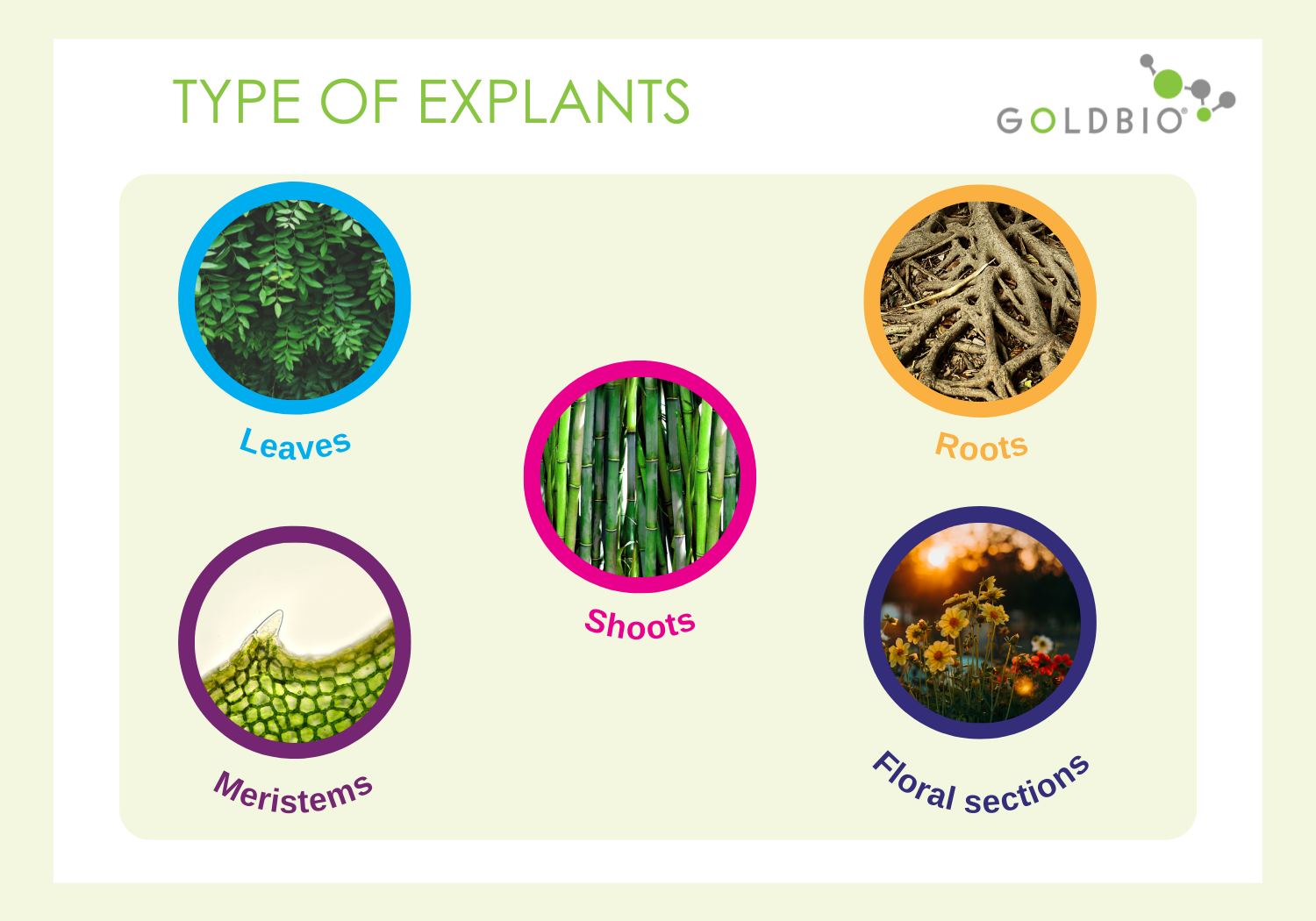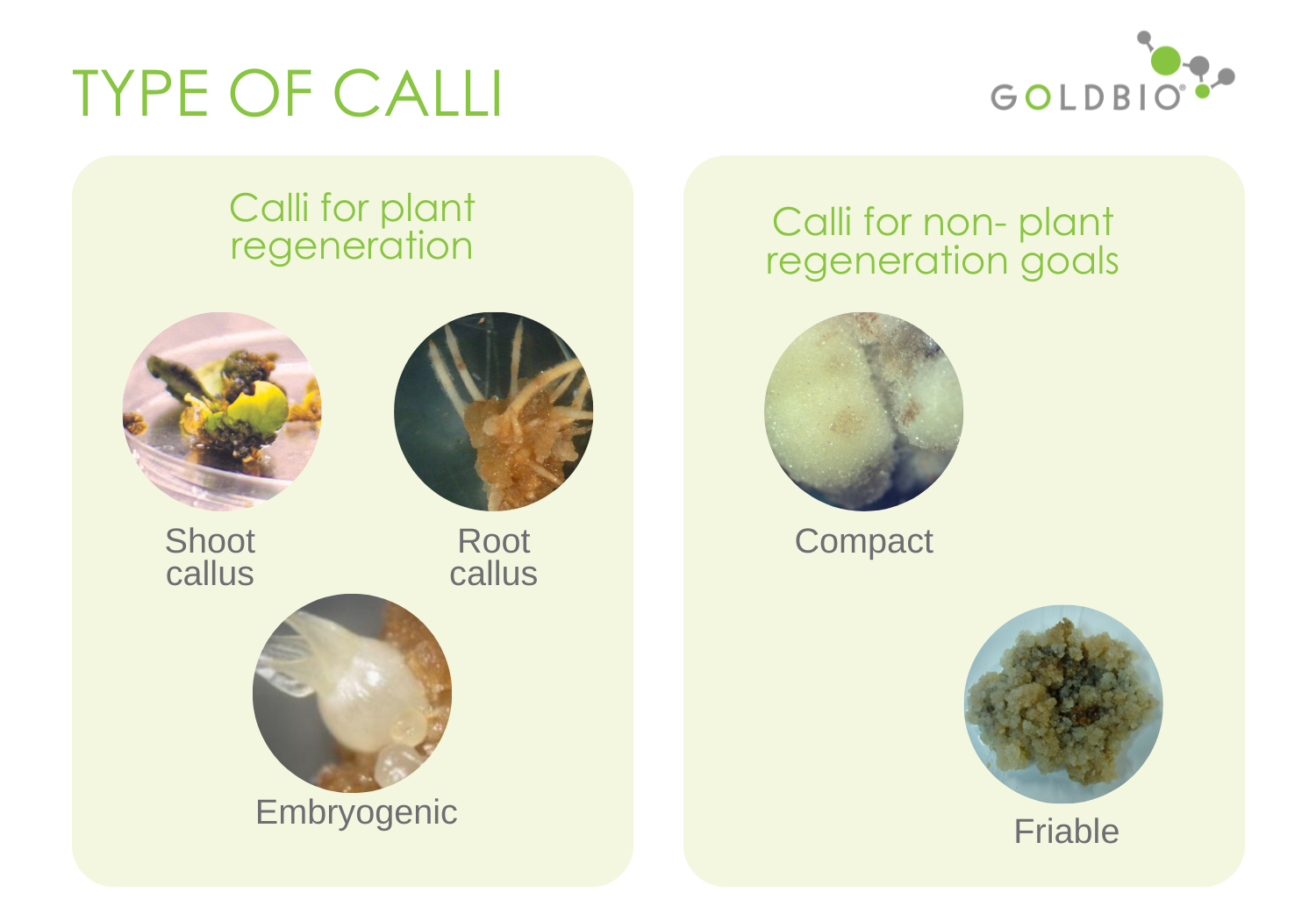All About Plant Explants and Calli – A Quick Overview
by Adriana Gallego, Ph.D.

by Adriana Gallego, Ph.D.
Whether you’re new to plant research, need a refresher or are coming in from another area of research, we’re providing a quick overview on plant explants and calli (callus – singular).

Figure 1. Examples of plant calli and plant explants
A plant explant is a fragment of plant tissue that is used as starting material for plant tissue culture. Examples of explants are root fragments, shoot fragments, leaf sections, petals, etc. From there, the explant can be used for regeneration or non-regeneration techniques.
A plant callus (calli-plural) is a mass of undifferentiated cells that grow over an explant as a result of wounding or when growth factors are added to culture media. A callus can give rise to shoot-buds and somatic embryos that can form complete plants. Or a plant callus can be transferred to a liquid medium and produce cells that are used to produce metabolites.

Figure 2. A callus can be used to plant suspension culture to produce metabolites, or in plant tissue culture that can lead to plant regeneration.
Both plant explants and calli have different types that we will explore.
In this article:
How to initiate plant calli growth
When it comes to types of plant explants, this is very easy to understand. For plant tissue culture, most any part of a plant fragment can be used as an explant. Common explants include fragments of leaves, roots, shoots, petals, and meristems
List of common explants

Figure 3. Visual examples of types of plant explants.
Other plant fragments can also be used, but an important consideration for explant selection and plant tissue culture is that the cells must be able to de-differentiate. For instance, floral, root and shoot sections are already developed so, they have to de-differentiate into a younger stage before initiating a callus.
Juvenile tissues such as meristems, on the other hand, are undifferentiated cells to begin with.
One relevant consideration is that cells undergoing de-differentiation can eventually follow the biological differentiation process and become organized cells such as organs or plants.

Figure 4. Conceptual image shows how differentiated tissues can undergo de-differentiation and then after de-differentiate can be differentiated.
Another important consideration of explant type is how easy or difficult it is to culture. For example, root tips are generally avoided because they often have contaminating microbes.
Aside from explant type, there are other factors for consideration when choosing an explant for plant tissue culture, including age, quality, when it was collected, and tissue culture goals
For tips on how to choose a plant explant and for a helpful
downloadable resource,
visit this article. This article has information about improving plant cell suspension cultures, choosing the appropriate explants and optimizing experimentation for success.
With that in mind, there are still some hidden obstacles when it comes to explants. For instance, different cultivars of the same species can have varying results in plant tissue culture.
And, even if your explants come from the same mother plant, there will be varied results because calli are produced at different frequencies.
Plant calli are classified into two types: a callus for plant regeneration and a callus that does not produce plants and is used for cell suspension and metabolite production.
These two classifications also have further subcategories.

Figure 5. Visual examples of regeneration calli: A shoo callus, root callus and an embryogenic callus.
A callus for plant regeneration: a plant regeneration callus produces organs such as shoots, roots, or embryos commonly used for plant micropropagation. This category can be subdivided into shoot calli, root calli, and embryogenic calli.
Though it goes without saying, calli in this category are used in plant tissue culture to yield or regenerate new plants.

Figure 6. Visual examples of non-plant regeneration calli: compact callus and friable callus.
A callus for non-plant regeneration purposes: Non-plant regenerating calli do not produce organs such as shoots, roots, or embryos. Instead, this type of callus remains as an unorganized mass of cells.

Figure 7. A friable callus. Cell suspensions are made from friable calli.
One of the most typical ways these calli are used in plant tissue culture is for plant cell suspension that produces metabolites for pharmaceuticals and other fields of biotechnology.
This callus can be further split into two kinds of calli based on their texture, such as compact and friable callus (Miao et al. 2013).
Calli can be formed by adding plant growth regulators such as cytokinins and auxins or by wounding signals after a cut on a tissue.
Compact calli can become friable calli after several subcultures in fresh media. The friability may vary according to the genotype, culture media composition, and explant type.

Figure 8. Summary image of regeneration and non-regeneration plant calli.
A plant callus can be initiated from one cell (unicellular) or multiple cells (pluricellular). The calli are homogeneous in the unicellular origin, and all cells look similar.
In pluricellular origin, multiple cells contribute to the initiation of heterogeneous calli.

Figure 9. Differences between pluricellular and unicellular calli initiation.
The cellular origin is particularly studied in embryogenic calli, which produce somatic embryos. In these embryos, the type of origin is related to the behavior of cells within a mass of cells.
The cells in an embryo with unicellular origin divide coordinately, while no cell coordination is found in embryos with pluricellular origin. A coordinated division means most of cells are under the cell division or elongation process in a given moment in the explant.
The cellular origin matters because embryos with unicellular origin usually lead to plants with better in vitro performance (plants growth normal).
Differentiation is a cellular process in which cells become what they were meant to be. For example, a meristem differentiates into floral, shoot, or root tissues.
De-differentiation is a cellular process in which cells return to an undifferentiated stage or juvenile. For example, a leaf cell would return to the undifferentiated meristematic cell type.
The friability is a morphological feature where calli present a soft texture and watery cells.
A meristem is a group of juvenile cells that produce all different types of tissues like roots, shoots, and flowers in a plant.
A plant growth regulator is a hormone-like substance that is exogenously added to the culture media to promote the plant's growth in tissue culture procedures.
A somatic embryo is not produced by cross pollination but derived from tissues like leaves, shoots, roots, or flowers by asexual propagation.
Plant tissue culture, callus, calli, explant, plant regeneration, plant cell suspension
Fehér, A. Callus, Dedifferentiation, Totipotency, Somatic Embryogenesis: What These Terms Mean in the Era of Molecular Plant Biology? (2019) Front. Plant Sci. 10:536. doi: 10.3389/fpls.2019.00536
Gulzar, B., Mujib, A., Qadir Malik, M., Mamgain, J., Syeed, R., & Zafar, N. (2020). Plant tissue culture: Agriculture and industrial applications. In Transgenic Technology Based Value Addition in Plant Biotechnology. INC. https://doi.org/10.1016/B978-0-12-818632-9.00002-2
Souza, J. M. M., Berkov, S., & Santos, A. S. (2014). Improvement of friable callus production of Boerhaavia paniculata rich and the investigation of its lipid profile by GC/MS. Anais Da Academia Brasileira de Ciencias, 86(3), 1015–1027. https://doi.org/10.1590/0001-3765201420130098

IPTG and auto-induction are two ways to induce protein expression in bacteria. They work similarly, but have different trade-offs in terms of convenience. While IPTG...

The final concentration of IPTG used for induction varies from 0.1 to 1.0 mM, with 0.5 or 1.0 mM most frequently used. For proteins with...

A His-tag is a stretch of 6-10 histidine amino acids in a row that is used for affinity purification, protein detection, and biochemical assays. His-tags...

Competent cells such as DH5a, DH10B, and BL21 will maintain their transformation efficiency for at least a year with proper storage. It is important to...
